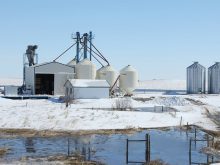The first year Clayton Kessler planted camelina, it grew into a field of chest-high lush plants.
That was in 2007 and the Pangman, Sask., farmer intends to plant it again.
“It worked really well. It started off dry and then got really wet, then dry again. Compared to the pea and canola crops in the area, (camelina) doubled their yield.”
He plans to grow it this year and sees a huge potential for the crop if the marketing is nailed down. He hoped rumours of a dedicated camelina crushing plant opening this fall in southern Saskatchewan come true.
Read Also

AgriStability updates offer stronger support for farmers
One of the most significant updates to the AgriStability program for the 2025 program year is the increase in the compensation rate.
“That would be just awesome.”
His wife, Lorrie, added that the crop’s omega 3 content in its cooking oil is a trump card because people are already changing the food they eat to get more of the omega fatty acids that are good for heart health.
The Kesslers are early onto the camelina bandwagon, which is being pulled by researchers and one marketer, Hugh Campbell of Terramax Corp. in Qu’Appelle, Sask.
Campbell told the Saskatchewan Herb and Spice Association Jan. 10 that he believes in the new oilseed’s future.
Camelina is new only to the Prairies. It was the oil the Romans ate and bathed with 2,000 years ago and it was widely grown in Europe and known as the gold of pleasure.
Its oil was used for cooking, as a skin lotion and to fuel lamps. Those three historic uses are why it is being touted in Saskatchewan as the next big oilseed.
Campbell ticked off its attributes. Camelina oil is high in omega 3 fatty acids and vitamin E, which makes it a healthy oil for human consumption.
It has a long shelf life and can sit on the counter without going rancid. The golden oil has a mild asparagus taste.
Campbell sends containers of the seed to Europe where it is processed into margarine, hand lotion and gel capsules. He is hoping a crusher opens soon in the province so he can send the oil to his customers.
Saskatchewan’s agriculture department sees camelina’s potential as another diversification for farmers.
It is funding research into the crop, along with Agriculture Canada and the Saskatchewan Canola Development Commission. Venikata Vakulabharanam of Saskatchewan Agriculture said the department sees camelina as possibly a good oilseed to grow in the hot, dry southwest in what is traditionally not a good area for oilseeds.
Its meal can produce up to 44 percent protein, making it more competitive as an animal feed than canola meal, at 36 percent, and it is cheaper to grow than canola, said Campbell. For industrial purposes, camelina is used to make hand lotions and it could be a biodiesel feedstock.
Agriculture Canada researcher Eric Johnson has finished the first year of a three year study into camelina’s agronomic requirements. He had good news for farmers in that camelina is frost and drought tolerant, a short-season crop ripening within 80 to 100 days and has good resistance to blackleg, a canola problem.
Also, insects like grasshoppers, armyworms and flea beetles aren’t interested in it. And it requires few inputs, making it cheaper to grow than other oilseeds.
On the troublesome side, Johnson found some strains of camelina aren’t consistent in quality or yield, it has no tolerance to broadleafed herbicides and the seeds are tiny and can be lost through shattering.














